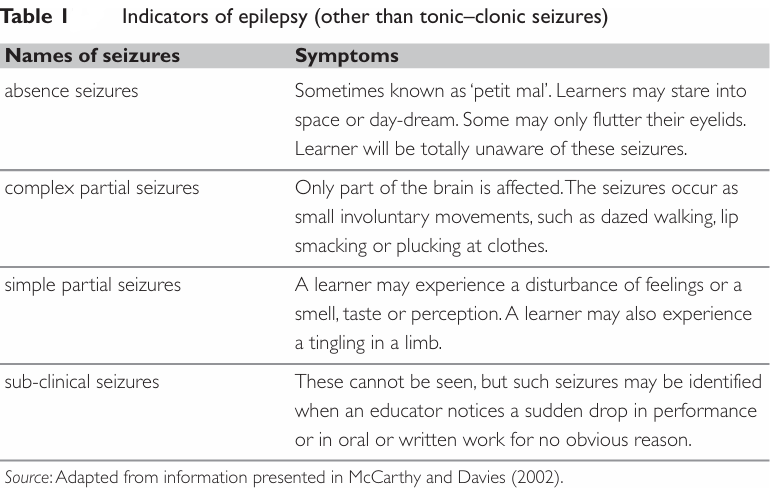
Epilepsy
 المؤلف:
Sue Soan
المؤلف:
Sue Soan
 المصدر:
Additional Educational Needs
المصدر:
Additional Educational Needs
 الجزء والصفحة:
P228-C15
الجزء والصفحة:
P228-C15
 2025-05-06
2025-05-06
 789
789
Epilepsy
Epilepsy is a neurological disorder that affects 1 in 200 of the population.
Epilepsy is an established tendency to recurrent seizures, which occur as a result of biochemical changes in the brain. It affects children of all ages, backgrounds and levels of ability. It is not an illness or disease, but is indicative of a physical disorder. (McCarthy and Davies, 1996)
If a child only has one seizure this would not necessarily indicate epilepsy. Epilepsy means that the child has recurring seizures. The symptoms and duration vary greatly depending on the type of epilepsy, but also it affects children in different ways. Epilepsy is abnormal brain functioning and this produces fits, attacks or seizures. Children may have muscle spasms, convulsions, involuntary movements and changes in perception and consciousness. These seizures are usually over in a few seconds or minutes, the same processes that caused the seizures having triggered other mechanisms in the brain stopping them.
The Tonic–Clonic Seizures, previously known as ‘grand mal’ epilepsy, are the most disturbing for all involved and indeed can be quite frightening not only for the child experiencing the seizure, but also for other pupils and adults. In this situation the child may make a noise and then fall quite suddenly, followed by convulsive jerks. Saliva around the mouth may then start appearing and some-times bladder or bowel control might be lost. Within a few minutes the child will regain consciousness, but is quite likely to feel dazed and confused for a few hours, very tired with the possibility of a headache developing.
If this is not the first time a child experiences a seizure it is not considered a medical emergency. However, a child may have caused harm to himself when he fell or may have been unconscious for quite a long time. If this is the case, it is always better to seek medical attention.
The other types of epilepsy are not so easily identified, but as one in three of the children with epilepsy fall behind academically, it is essential that educators are aware of signs that MAY indicate a neurological disorder. Table 1 in illustrates the type of epilepsy and some of the symptoms.

Discussion
As has been mentioned, learners with epilepsy experience seizures in many different ways. Can you think of a learner who may possibly be experiencing a form of epilepsy?
 الاكثر قراءة في Teaching Strategies
الاكثر قراءة في Teaching Strategies
 اخر الاخبار
اخر الاخبار
اخبار العتبة العباسية المقدسة


